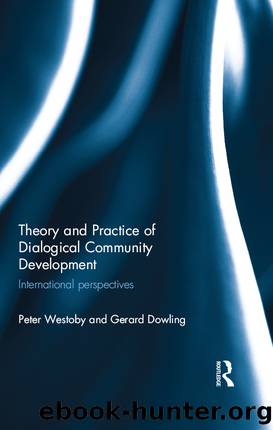Theory and Practice of Dialogical Community Development by Westoby Peter;Dowling Gerard;

Author:Westoby, Peter;Dowling, Gerard;
Language: eng
Format: epub
ISBN: 1172911
Publisher: Taylor & Francis Group
It would be possible to look at many other case studies that show how to structure transformative work beyond even the regional and provincial and move into a national and transnational scope. For example, Judy Wicksâ work in forming the Business Alliance for Local Living Economies (BALLE) (Wicks 2004), South Africaâs Treatment Action Campaign (Green 2008), the La Via Campesina movement (McMichael 2012: 208ff.) and the Shack Dwellers International movement (Patel 2010) are just a few that have intrigued us over the years.
Closer to home, some colleagues have been building a different kind of regional structure on the Sunshine Coast of southeast Queensland. Their work is a response to decisions of some government departments to grant funding only to regionally oriented organisations. The consequence was that many years of local community effort invested in building local neighbourhood centres came under threat. Large organisations, often with no local base, were applying for and winning state funding opportunities. They had the capacity to employ consultants to prepare impressive applications â and then ironically started to network with the local neighbourhood centres to build local contacts, understanding and credibility. The local neighbourhood centres in the region decided to fight back:
In 2007 four local structures: the Caloundra Neighbourhood Centre, the Hinterland Community Development Association, the Maroochy Neighbourhood Centre and Nambour Community Centre, decided to get together and start a process of forming a regional structure that would be able to compete within the regionally oriented funding market, yet be structured in such a way as to remain grounded within the local work of the neighbourhood centres. The Sunshine Coast Community Co-op was formed. It acts not as a âsuper-structureâ that swallows up each local organisation, but as an enabling structure that respects each of the organisations. Each organisation is developing capacity to engage with the issues, both in its own areas and also across the region.
(Buckley 2007: 2)
The story of this organisation illustrates some innovative ways to structure the work so that local issues can be engaged with at a regional level, but still remain small enough for local people to participate. The structures remain as peopleâs infrastructure â built from the bottom up, drawing on horizontal relationships (between neighbourhood centres and associations) and yet able to interact with the vertical formal system (usually donors or/and government). Such a model provides an alternative pathway to the conventional practice of large NGOs simply dropping in with a ready-made âblueprintâ approach to provision of services.
Structures as peopleâs structures, not service-oriented agents
The approach of the large non- or for-profit organisations critiqued above is to legitimise their work and âdropping inâ on localities by demonstrating a need for provision of their services. They often become experts at creating need, and then argue to communities and governments (often the donors) that they are the experts at addressing that need â ironically through their services (McKnight 1995), which are provided to the detriment of community-based responses to local challenges. The following story considers a case study of how to re-imagine
Download
This site does not store any files on its server. We only index and link to content provided by other sites. Please contact the content providers to delete copyright contents if any and email us, we'll remove relevant links or contents immediately.
International Integration of the Brazilian Economy by Elias C. Grivoyannis(57392)
The Radium Girls by Kate Moore(10916)
Turbulence by E. J. Noyes(7058)
Nudge - Improving Decisions about Health, Wealth, and Happiness by Thaler Sunstein(6643)
The Black Swan by Nassim Nicholas Taleb(6204)
Pioneering Portfolio Management by David F. Swensen(5616)
Rich Dad Poor Dad by Robert T. Kiyosaki(5164)
Zero to One by Peter Thiel(4835)
Man-made Catastrophes and Risk Information Concealment by Dmitry Chernov & Didier Sornette(4749)
Secrecy World by Jake Bernstein(3789)
Millionaire: The Philanderer, Gambler, and Duelist Who Invented Modern Finance by Janet Gleeson(3576)
Skin in the Game by Nassim Nicholas Taleb(3479)
The Age of Surveillance Capitalism by Shoshana Zuboff(3432)
The Money Culture by Michael Lewis(3291)
Skin in the Game: Hidden Asymmetries in Daily Life by Nassim Nicholas Taleb(3273)
Bullshit Jobs by David Graeber(3190)
The Dhandho Investor by Mohnish Pabrai(3176)
The Wisdom of Finance by Mihir Desai(3087)
Blockchain Basics by Daniel Drescher(2896)
